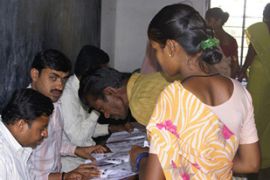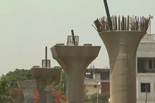India holds second round of vote
Turnout in biggest phase of election affected by heat wave and threats of Maoist attacks.

The Indian army had been put on alert across the 13 states where the second round of voting was being held.
Uneven turnout
Turnout started strong in the early morning hours, but slowed down as temperatures reached 44 C.
One election official was reportedly killed by the heat and another was admitted to hospital in Orissa, a spokesman for the eastern coastal state’s election commission said.
| In depth | |||||
 Features and analyses on India’s general election
| |||||
|
Turnout in Jharkhand was about 50 per cent while in neighbouring Bihar it was only 45 per cent. Even in Uttar Pradesh, India’s most populous state, the figure was 43 per cent, according to a state official.
But in the southern state of Andhra Pradesh turnout was 65 per cent, attributable to the fact that the region’s most famous film star recently entered the political arena.
Manmohan Singh, the Indian prime minister, cast his vote under tight security in Dispur, capital of the northeastern state of Assam, which was plagued by a string of bomb attacks in the run-up to the election.
Surveys indicate that neither Singh’s Congress, which leads the governing coalition, nor the main opposition party, BJP, will win enough seats in the lower house of parliament to rule on their own.
Although large cities such as Bengaluru, formerly known as Bangalore, and Pune are going to the polls during the second round, urban residents comprise only 22 per cent of the electorate.
But more people from within the urban voter base were expected to vote in this election compared to the previous one, largely due to a “get out and vote” campaign by the major parties.
“Traditionally the urban voting percentage was between 40 per cent and 45 per cent. This time there have been a lot of campaigns urging people to cast their votes,” Trilochan Sastry, from the Association for Democratic Reforms, told Al Jazeera.
“Even if the number goes to 50 per cent, it will be significant.”
Economic concerns
Reporting from Bengaluru, which is also India’s IT hub, Al Jazeera’s Matt McClure said that ordinary people were worried about the ailing economy, potential job losses and internal security in the wake of last November’s Mumbai attacks.
| The second round |
|
The second round of voting takes place in Andhra Pradesh (20 seats), Assam (11), Bihar (13), Goa (2), Jammu and Kashmir (1), Karnataka (17), Madhya Pradesh (13), Maharashtra (25), Manipur (1), Orissa (11), Tripura (2), Uttar Pradesh (17) and Jharkhand (8). The second phase covers the highest number of seats in the 545-member Lok Sabha, or lower house of parliament. Farmers and agricultural workers constitute about 71 per cent of the people voting in the second round. One out of every three agricultural labourers in the country could be casting his or her vote today. Polling has already been completed in 124 seats in the first phase on April 16. The remaining phases will be held on April 30 and May 7 and 13. |
But they do not expect tangible change from their country’s politicians, he said.
“In the lead-up to today’s voting we didn’t hear the national leaders discussing their solutions for these problems, rather the discussion and debate has focused on who is going to ally with who,” our correspondent said.
“When the voting is all done and the ballots are all counted, as everyone is predicting, no one will have a majority.”
The national election began on April 16 and will continue for a month, with results expected on May 16.
With more than 700 million eligible voters, India normally holds staggered elections for logistical and security reasons.
Voters in two states – Andhra Pradesh and Orissa – will also choose state assembly candidates.
Train attacked
The day before the second round vote, about 200 Maoist fighters stopped a train and held the passengers hostage for several hours in the eastern state of Jharkhand.
All the passengers were released unharmed and there was no confrontation with security forces.
The hijacking on Wednesday was one of a series of attacks that included an explosion at another railway station, a blast at a government office, and the killing of a lorry driver in Bihar.
The fighters have called on the public to boycott the election, and a pamphlet left at the attacked government office described the vote as “a fake exercise”.
“Strengthen revolutionary forces. You will pay with your lives if you participate in these elections,” it read.

